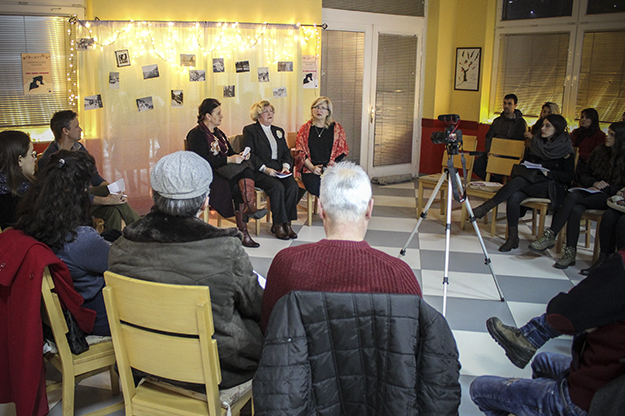In January, a “Storytelling Caravan” was held in the southern part of the city of Mitrovica. The event, aimed at restoring memories of a city that was once unified, culturally and socially, was held at the Diakonie Youth Center, located near the River Ibër, which flows through the city and is now considered a symbol of its division.
As part of the Mitrovica Joint Stories project, organized by GAIA — a non-governmental organization that is a subsidiary of Service Civil International (SCI) — the event showcased the stories of three Mitrovica women of different ethnicities: Valbona Prekazi (Albanian), Jasmine Kurshumlija (Bosnian) and Ružica Simić (Serb). All three of them in their 50s and 60s, shared memories of their lives over the years, spent on two sides of the city.
Exhibited on the walls of the youth center, strung up behind the storytellers, were photographs of women from Mitrovica from a time when the city was unified. The photos were provided by the Mitrovica Museum, the local project partner.
During the event, the featured storytellers shared their earliest memories of the city. Reflecting upon their favorite places from earlier times, they spoke about how Mitrovica, years ago, differed from other cities regarding traditions and cultural life; it was the city of rock bands, parties, sports, economic and industrial development. Furthermore, they spoke about the role of women in the former society.
Despite living in the same city at a time of great cultural diversity, the memories of Prekazi, Kurshumlija and Simić were unique to each woman. Still, these stories of the old city of Mitrovica were juxtaposed with a Mitrovica in oblivion, a divided city that hosts a completely different life today from that which was lived not long ago.

Valbona Prekazi, Jasmina Kurshumlija and Ružica Simić shared their memories of the city of Mitrovica. Photo courtesy of Besim Ibrahimi.
Valbona Prekazi, a professor in the city’s Technical High School, says one of her earliest memories of the city is that of her first impression when she and her family arrived in Mitrovica from Prizren in the ’60s.
“The sight of the River Ibër captivated us. It was vast and deep, and above it [there was] a glamorous metal bridge,” said Prekazi, who was particularly impressed by Mitrovica’s urban planning.
“In the middle of the city, there was a park. The park was outstandingly beautiful at the time. It had a pool in the middle, and lots of flowers and conifers around, through which light couldn’t penetrate.”
She recalled that, on Sundays, she would join tens of thousands of other spectators in the Trepça stadium on the northern side of the park to watch the match. “Trepça’s team was always renowned. It entered the first league of Yugoslavia,” she said, before continuing on to highlight Mitrovica’s industrial zone.
“We travelled by train, and around midnight, when we got to Mitrovica, we were fascinated by the lights seen from the entrance of the city, coming from the developed industrial zone,” she said.
Ružica Simić, director of the NGO Women’s Rights, also recalls this lighting.
“What impressed me the most was the illumination of the city,” Simić said. “Seeing that I come from Stantërg, a small place, I was impressed by the public lighting from the beginning of the city to the end, [at the River] Sitnica.”
The city of Mitrovica reminds Simić of a time when society was more unified and people socialized regardless of their background.
“The collective aspect was very important at the time,” she said. “We got together with other families and went out. We never cared about social background. We just wanted to go out and have fun.”

